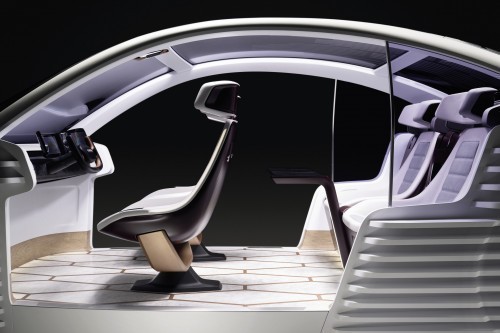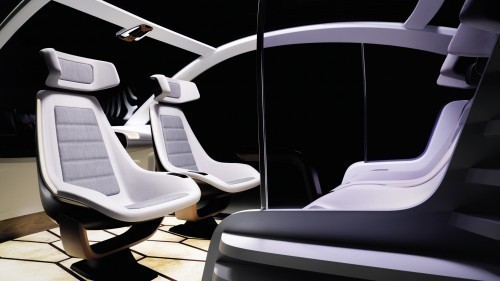Although it is still a big step to the autonomous car of the future, electromobility, connectivity and car sharing are already placing completely new demands on the use of vehicles. This is also reflected in the design - both in terms of electronic devices and the design of their user interfaces, as well as in terms of materials and surfaces. Together with partners,Covestro has developed a premium concept with various material solutions.
"Plastics and technologies will play a central role in the design of the future car cockpit," says Jochen Hardt, Vice President Global Marketing Mobility and coordinator of the concept. "Our comprehensive concept offers material solutions for functionality, comfort and design, but it also takes into account the wishes of the automotive industry for brand differentiation as well as increased efficiency and light weight."
Highlights of the concept include multi-sensory infotainment systems, innovative seating concepts and a soundproof dome. The high-tech materials open up a kaleidoscope of new possibilities for many different components.
Three-dimensional multifunctional display
In the car interior of the future, displays and display instruments will play a particularly important role. They will become infotainment systems that connect the occupants with the outside world and provide them with information or entertainment as required. This means that the car will also be a mobile, multifunctional living and working space. The innovation driver here is the interaction between people, cars and their surroundings. Displays will remain the main component of this interaction more than ever, and the demands on their functionality and design will increase significantly.
In order to see this challenge as an opportunity, new concepts in display design and good integration in the car cockpit are required. Together with an industrial partner, Covestro has developed a display concept that meets the increased requirements in terms of optical quality, durability and design standards. This collaboration resulted in the largest three-dimensional OLED display to date as a seamless interface between people and cars.
Curved surface, clear image
Two Covestro materials were used in the display concept: Makrolon Ai polycarbonate and Makrofol polycarbonate film. Both thermoplastic products can be processed into geometrically challenging components of good quality and durability. The high optical purity of the polymers ensures brilliantly clear colors of the OLED display (organic light emitting diodes) without image distortion due to the curved surface. The seamless, three-dimensionally shaped multifunctional display presented offers a large-format, visual experience for the user,
 Fig. 2: New material mixes and design concepts determine the ambience in future automobiles
Fig. 2: New material mixes and design concepts determine the ambience in future automobiles
Covestro was able to draw on its many years of experience in process development for the production of such highly complex components. A sophisticated combination of manufacturing technologies ensures the surface design and durability. The surface, shape, feel and look of the component can be individually adapted to the customer's wishes.
Vegan seat covers and individual rest areas
If the classic function of the driver's seat becomes obsolete with the possibilities of autonomous driving, the car interior can be completely redesigned. The seats should not only be comfortable, but also offer enough flexibility to increase the interior space.
"Our vegan aqueous INSQIN textile coating technology offers an appearance that is just as good as leather, but at a lower cost and with reduced solvent emissions," explained Thomas Michaelis, Head of Textile Coating in the Europe, Middle East, Africa and Latin America region. "What is attractive here is the possibility of allowing light to shine through the coated surface, creating a whole new kind of ambient lighting."
The new movable PrivacyDome serves to protect privacy. A sound-absorbing acoustic foam based on the Baynat polyurethane system provides each passenger with individual peace and quiet, independent of other passengers and the outside world.
 Fig. 3: The driver's seat will lose its significance in the next generation of vehicles. Instead, spacious areas will be created even in the smallest of spaces
Fig. 3: The driver's seat will lose its significance in the next generation of vehicles. Instead, spacious areas will be created even in the smallest of spaces
The following considerations were taken into account when developing these solutions: on the one hand, mobility has become quieter with the electric drive. But even the passenger in an electric car will not be able to drive acoustically shielded from their surroundings: The quieter the engine, the louder the sounds of road traffic reach the ear, and from a speed of 30 kilometers per hour at the latest, the rolling noise of the tires increases to such an extent that the noise level inside an electric vehicle is comparable to that of a car with a combustion engine. The need for noise reduction therefore remains a central element in the design of vehicle interiors.
Furthermore, there have already been some changes in user behavior and this trend is increasing: for a long time, the rule was "the driver determines the route, the passenger the music." In the meantime, this has changed completely on family trips, for example - often only the driver listens to a program from the car speakers. Everyone else has Bluetooth headphones on and listens to their own playlists. In the future, the number of people who decide to share a vehicle for economic reasons and travel distances together will increase considerably. The desire for privacy is even more important than for family trips.
Car manufacturers can respond to this trend with appropriate concepts: Shared vehicles from car-sharing providers, for example, can be designed in such a way that passengers' personal needs for music or peace and quiet are taken into account. Covestro has developed a new material solution for soundproofing the interior. It is part of a premium concept for the future design of car interiors. The so-called PrivacyDome - an automatically retractable dome above a passenger's head that protects him or her from noise and disturbing sounds - meets all these aspects. The Baynat polyurethane system, which has proven its worth in soundproofing car interiors, was used in this dome. As a result, passengers can enjoy peace and quiet independently of other passengers - exactly when they want it. By integrating loudspeakers in the PrivacyDome, it is even possible to select individual music.
Key data on Covestro
With a turnover of €12.4 billion in 2019, Covestro is one of the world's largest polymer companies. Its business focuses on the production of high-tech polymer materials and the development of innovative solutions for products that are used in many areas of daily life. The most important customer industries are the automotive industry, the construction industry, the wood processing and furniture industry and the electrical and electronics sector


